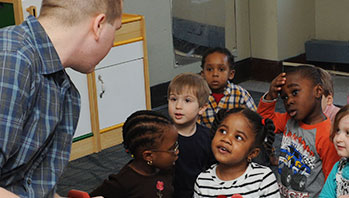- high
- loud
- soft
- sound
- talk
MA Standards:
Speaking and Listening/SL.PK.MA.1: Participate in collaborative conversations with diverse partners during daily routines and play.
Language/L.PK.MA.1: Demonstrate use of oral language in informal everyday activities.
Language/L.PK.MA.6: Use words and phrases acquired through conversations, listening to books read aloud, activities, and play.
Head Start Outcomes:
Language Development/Receptive Language: Attends to language during conversations, songs, stories, or other learning experiences.
Language Development/Expressive Language: Uses language to express ideas and needs.
Logic and Reasoning/Reasoning and Problem Solving: Classifies, compares, and contrasts objects, events, and experiences.
PreK Learning Guidelines:
English Language Arts/Language 2: Participate actively in discussions, listen to the ideas of others, and ask and answer relevant questions.
Talk Together: High or Low? Loud or Soft?

© Commonwealth of Massachusetts, Department of Early Education and Care (Jennifer Waddell photographer). All rights reserved.
STEM Key Concepts: Sounds have a source; Different objects make different sounds; Sounds vary in three ways: volume, pitch, and timbre
ELA Focus Skills: Speaking and Listening, Vocabulary
Continue reviewing the different sounds that children can make with their voices. Talk with children about how their voices change when they talk to other people. Have children listen to the sound of your voice when you ask a question and when you want to get the attention of someone who is across the table.
- Emphasize the pitch at the end of the question as you ask, What do you want to do with the blocks?
- Make your voice louder and more direct when you say, Shantrel, I like your paper cup house.
Discuss how the sound of your voice changes when you are asking a question, telling a joke, laughing, etc. Encourage children to think about different ways they change their voices. Have them demonstrate other ways their voice changes such as, yelling loudly across the playground, whispering softly when their little brother is sleeping, use a high pitched voice when excited, etc.)
